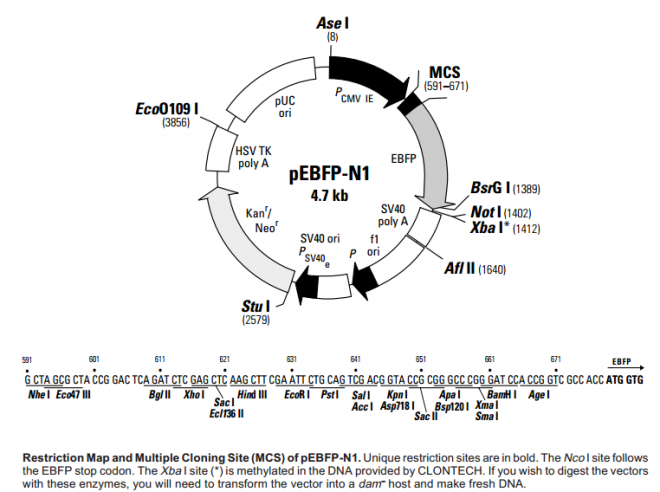
|
品牌 |
酶研生物 | |||||||||||||||||
货号 |
MY1117 | |||||||||||||||||
规格 |
2ug | |||||||||||||||||
价格 |
询价 | |||||||||||||||||
货期 |
现货 | |||||||||||||||||
pEBFP-N1 carries a blue fluorescent variant of the Aequorea victoria green fluorescent protein gene (GFP). The EBFP gene contains four amino acid substitutions. The Tyr-66 to His substitution gives EBFP fluorescence excitation and emission maxima (380 and 440 nm, respectively) similar to other blue emission variants (1–3). The other three substitutions (Phe-64 to Leu; Ser-65 to Thr; and Tyr- 145 to Phe) enhance the brightness and solubility of the protein, primarily due to improved proteinfolding properties and efficiency of chromophore formation (1, 4, 5). The Em of EBFP is 31,000 cm–1M–1 for 380-nm excitation, leading to a fluorescent signal that is 2–3-fold brighter than other blue variants of GFP and roughly equivalent to wt GFP. In addition, the rate of photobleaching of EBFP is one-half to one-third that of P4-3, a popular predecessor to EBFP (1). EBFP contains >190 silent mutations that create an open reading frame comprised almost entirely of preferred human codons (6). Furthermore, upstream sequences flanking EBFP have been converted to a Kozak consensus translation initiation site (7). These changes increase the translational efficiency of the EBFP mRNA and consequently the expression of EBFP in mammalian and plant cells. The MCS in pEBFP-N1 is between the immediate early promoter of CMV (PCMV IE) and the EBFP coding sequences. Genes cloned into the MCS will be expressed as fusions to the N-terminus of EBFP if they are in the same reading frame as EBFP and there are no intervening stop codons. The inserted gene should include an initiating ATG codon. EBFP with N-terminal fusion moieties retain the fluorescent properties of the native protein and thus can be used to localize fusion proteins in vivo. The vector contains an SV40 origin for replication and a neomycin resistance (Neor ) gene for selection (using G418) in mammalian cells. A bacterial promoter upstream of this cassette (P) expresses kanamycin resistance in E. coli. The vector backbone also provides a pUC19 origin of replication for propagation in E. coli and an f1 origin for single-stranded DNA production.
|
|
|||||||||||||||||










